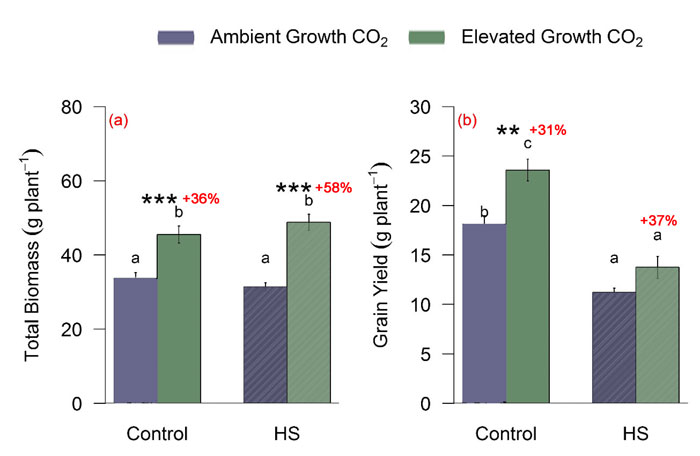| Tweet | Follow @co2science |
Paper Reviewed
Chavan, S.G., Duursma, R.A., Tausz, M. and Channoum, O. 2019. Elevated CO2 alleviates the negative impact of heat stress on wheat physiology but not on grain yield. Journal of Experimental Botany 70: 6447-6459.
Introducing their work, Chavan et al. (2019) write that "developing wheat varieties ready for future climates calls for improved understanding of how elevated CO2 and heat stress interactively impact wheat yields." And thus they went on to explain how they had examined the interactive effects of elevated CO2 and heat stress on the photosynthesis, biomass and grain yield of wheat.
The experiment was conducted in controlled-environment glasshouses at the Hawkesbury campus of Western Sydney University, Richmond, New South Wales, Australia. The authors utilized a commercial wheat cultivar, Scout, which they describe as a "high yielding variety with very good grain quality [that] contains a putative high transpiration efficiency gene which can increase water use efficiency." The CO2 concentrations examined in the study included ambient (419 ppm) and elevated (654 ppm). Temperatures were maintained at 22/15 °C (day/night) in the control treatment. Then, thirteen weeks after planting heat stress was enacted on half the plants in each CO2 treatment by raising the day/night temperatures to 40/24 °C for five days. Thereafter, the heat-stressed plants were returned to the control temperatures. Adequate water was supplied to all treatments throughout the experiment so as to avoid confounding effects of water stress.
In discussing their findings, Chavan et al. report that elevated CO2 enhanced net photosynthesis by 36% in non-heat stressed plants, whereas high temperature stress reduced this parameter by 42%. In the combined elevated CO2 and heat stress treatment, net photosynthesis was not reduced because, in the words of the authors, "elevated CO2 protected photosynthesis by increasing ribulose biphosphate regeneration capacity and reducing photochemical damage [caused by] heat stress."
With respect to biomass and yield, as shown in the figure below, elevated CO2 stimulated these two parameters by 36% and 31%, respectively, in the control treatment. Heat stress alone, in contrast, induced a small non-significant reduction in total biomass and a 44% reduction in grain yield. When elevated CO2 and heat stress were combined, total biomass increased by 46% over the control treatment (ambient CO2 and non-heat stress) and by 58% relative to the heat stress treatment under ambient CO2. Grain yield, on the other hand, experienced a 23% decline in the combined elevated CO2 and heat stress treatment relative to control conditions, but a positive 37% increase relative to heat stress alone at ambient CO2. Thus, in the future, elevated CO may well be able to ameliorate a large portion of the negative impact of high temperature stress on grain yield.
Commenting on their findings, Chavan et al. state that "heat stress caused irreversible photosynthetic damage at ambient CO2, while growth at elevated CO2 mitigated the negative impact of heat stress on photosynthesis." Additionally, they say that "plant biomass completely recovered from heat stress under both CO2 treatments due to the development of additional late tillers and ears; yet these did not fully develop and fill grains," which explains the drop in grain yield observed under heat stress. Consequently, they advocate for more research and breeding programs designed to improve grain filling and translocation of plant resources to the grain at high temperatures and elevated CO2 to protect future food production. In the meantime, as demonstrated in Figure 1 below, the air's rising CO2 content will help ameliorate the negative influence of high temperature stress on wheat grain yields.

Figure 1. Total biomass (a) and grain yield (b) of wheat plants at harvest in response to elevated CO2 and heat stress (HS). Values represent means ± SE using two-way ANOVA. Means sharing the same letter in the individual panels are not significantly different according to Tukey's HSD test at the 5% level. Statistical significance levels (t-test) for eCO2 effect are shown as follows: ** P < 0.01: *** P < 0.001. The percentages in red text indicate the change in biomass or grain yield due to elevated CO2 under control or heat stress conditions. Source: Chavan et al. (2019).




